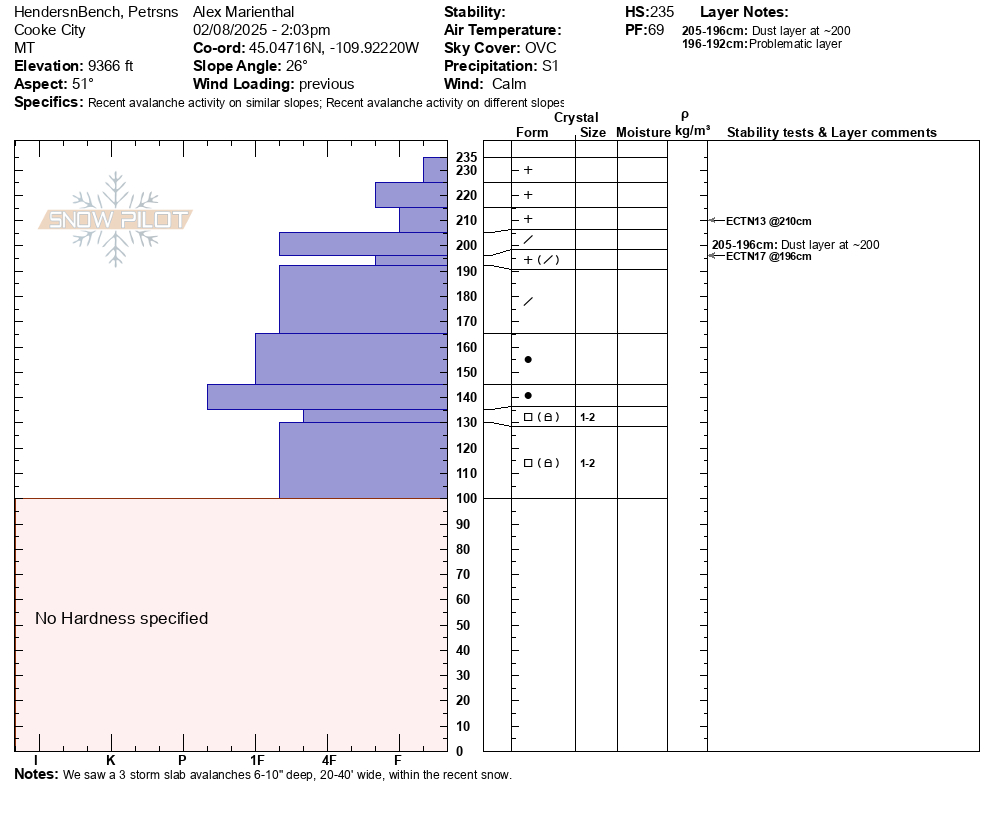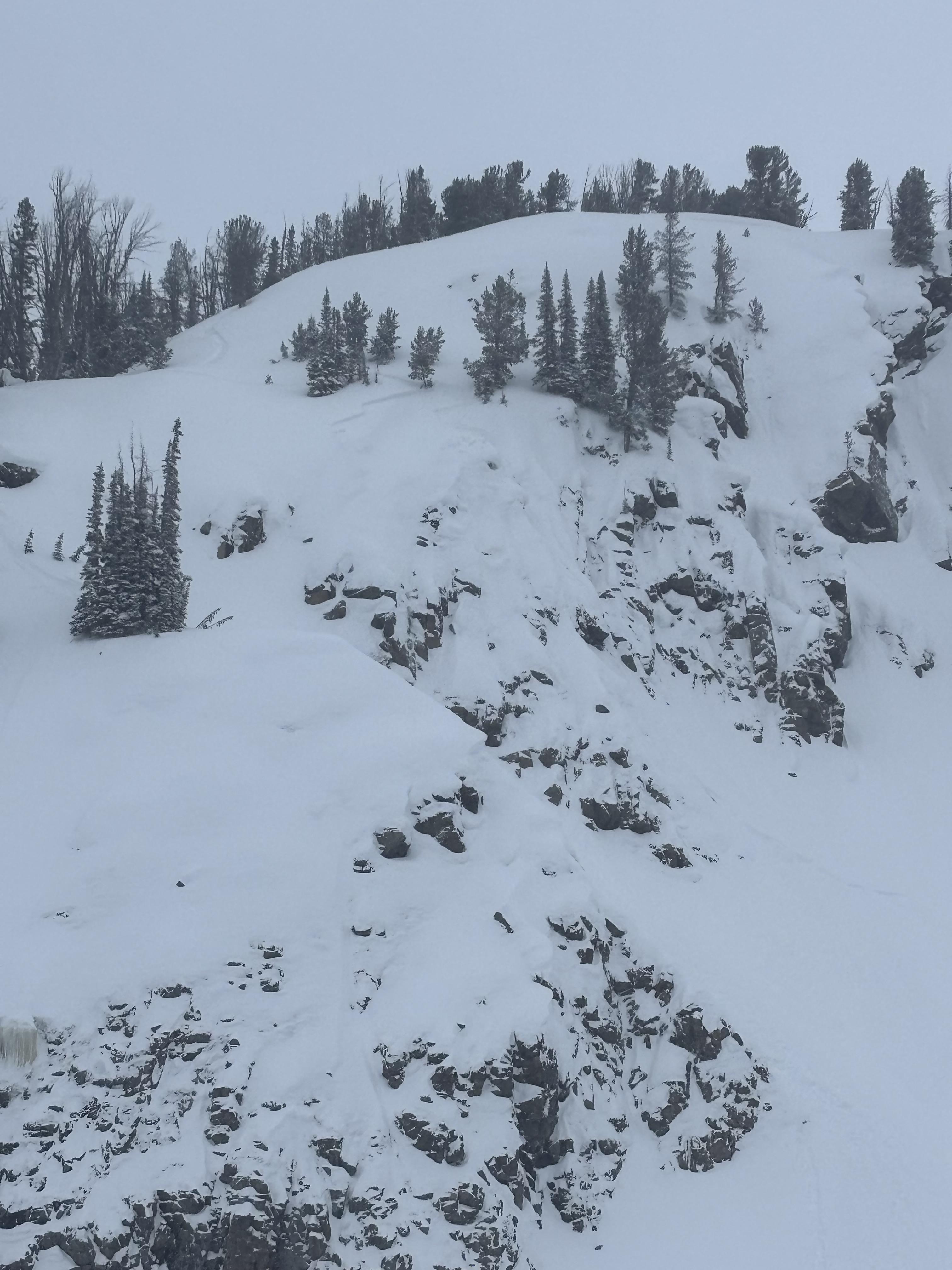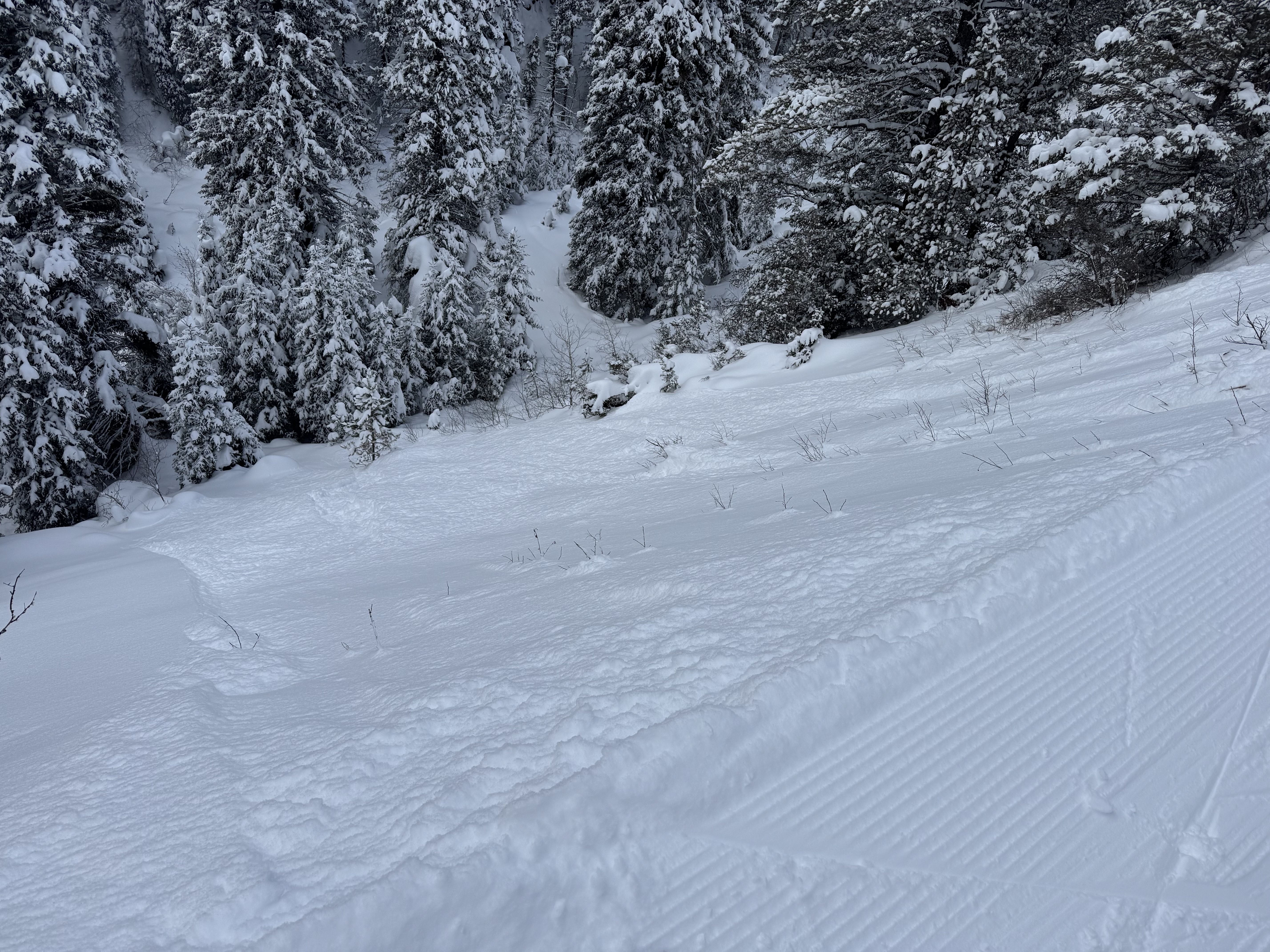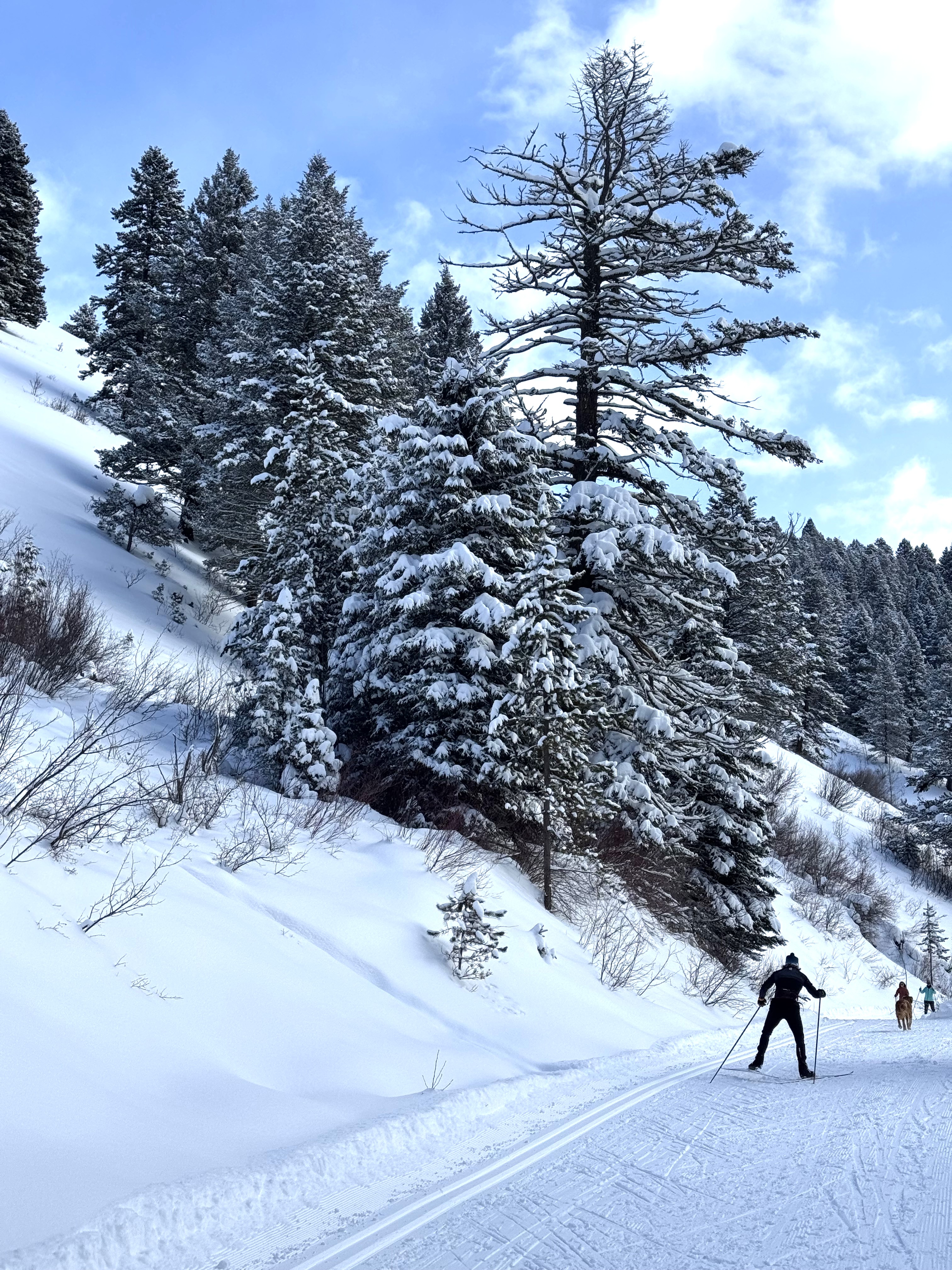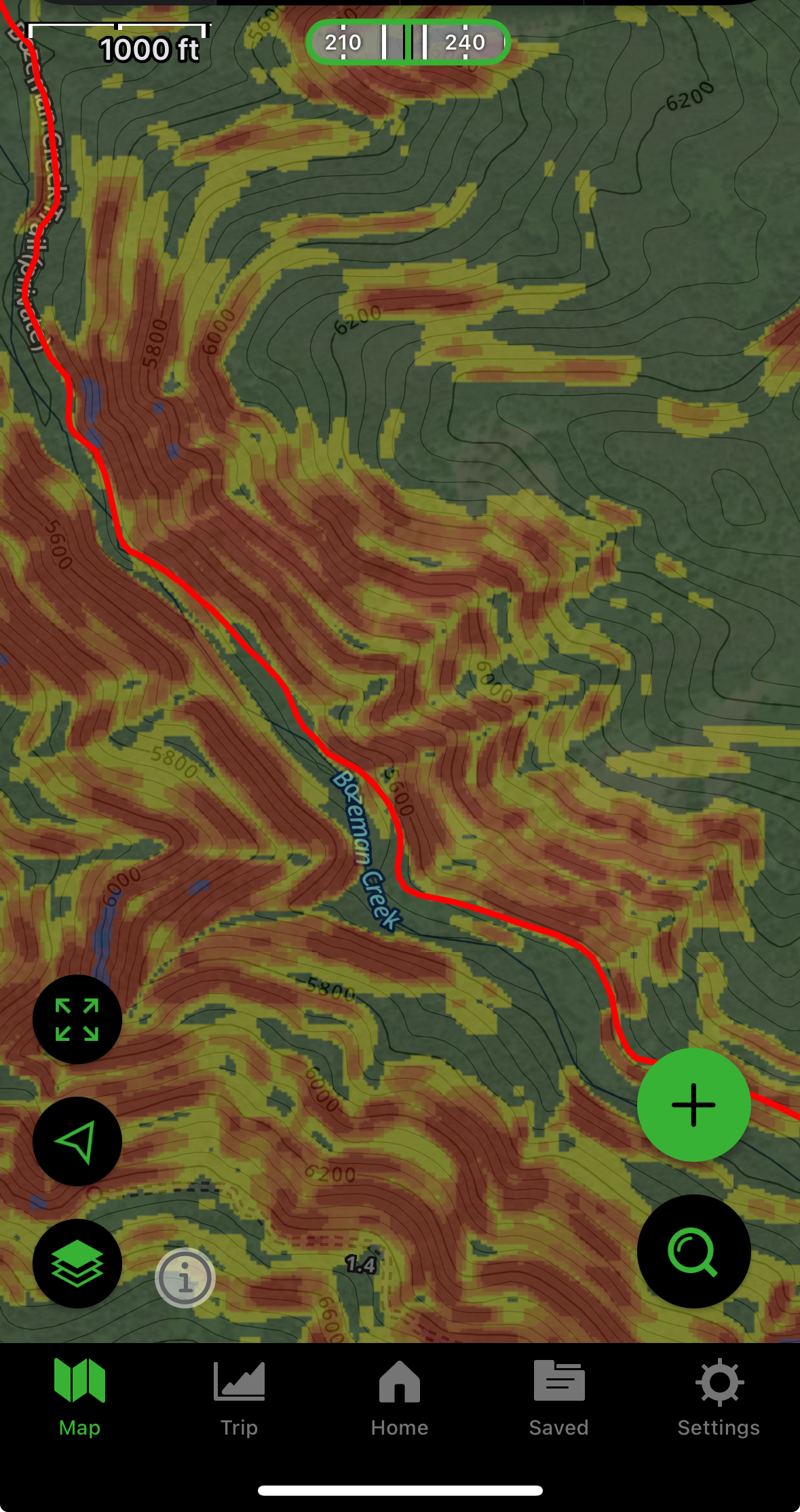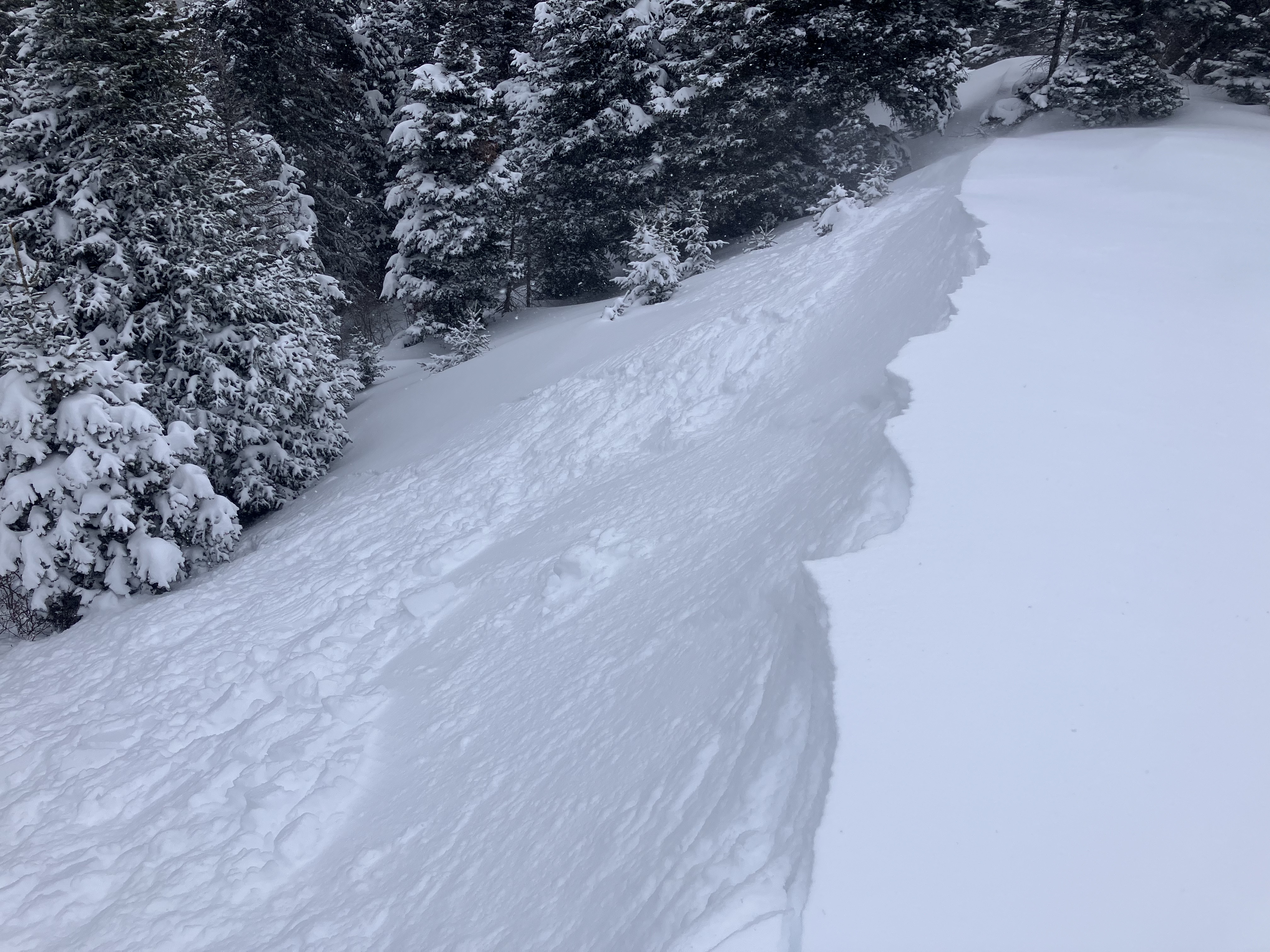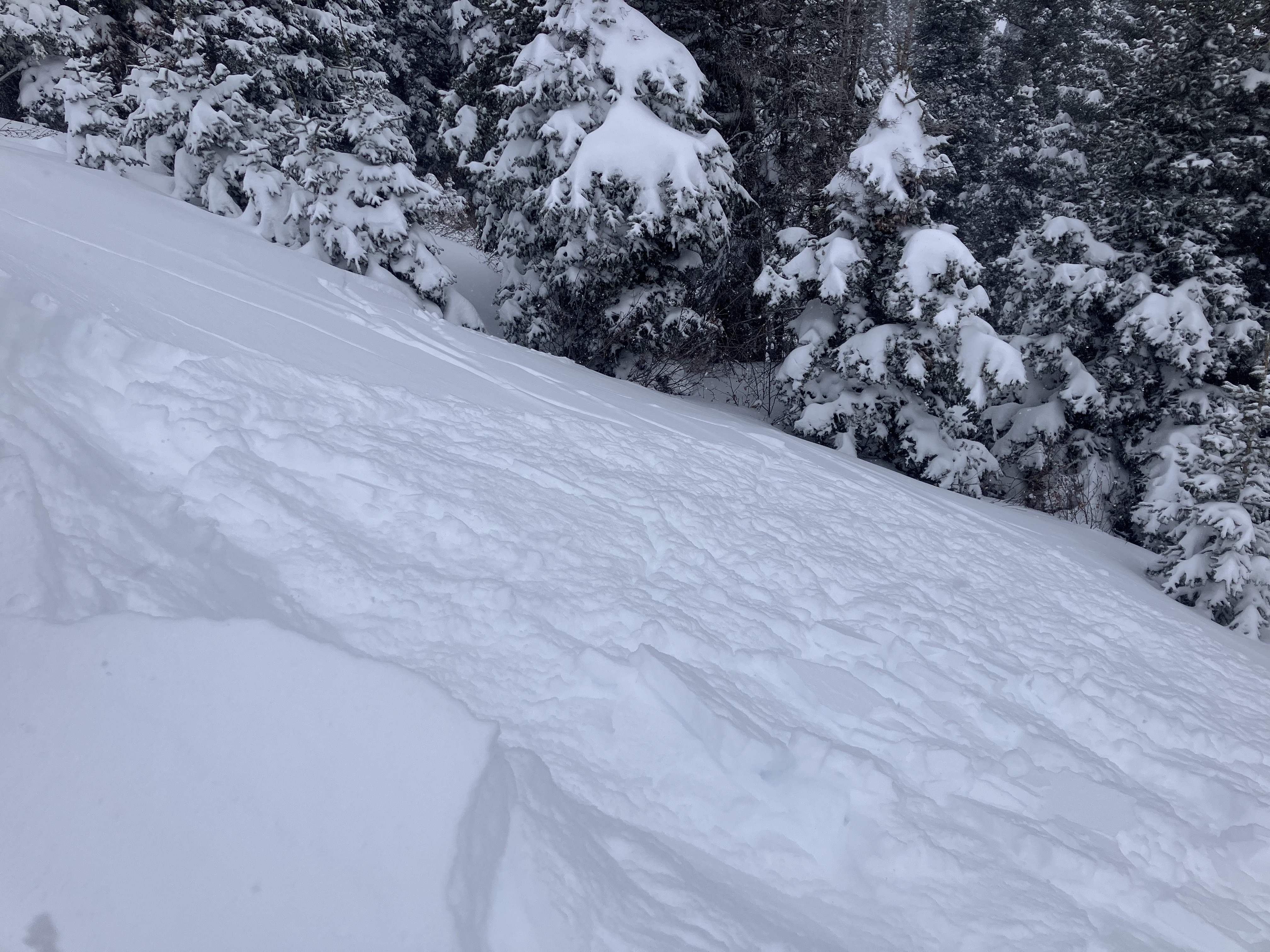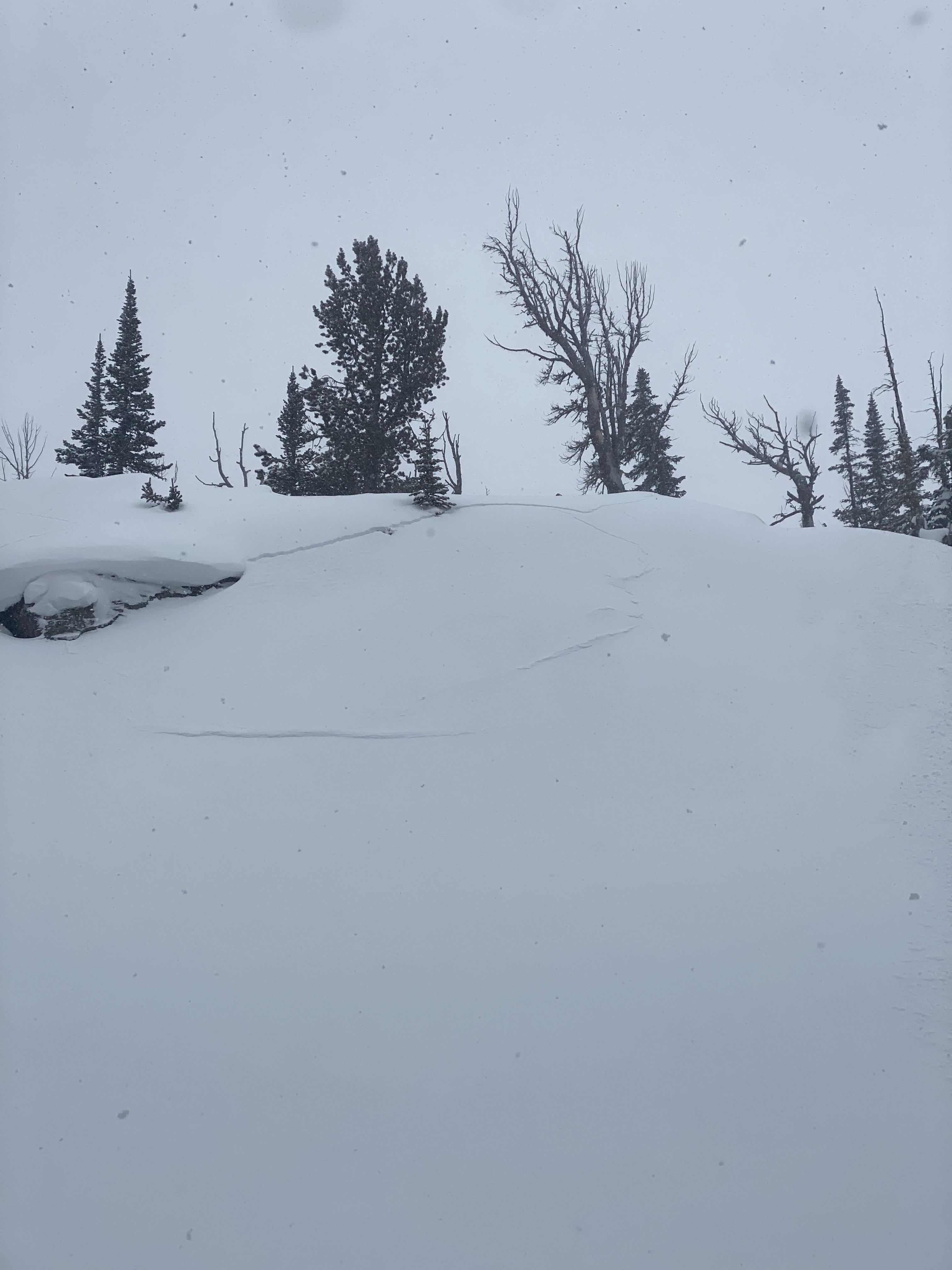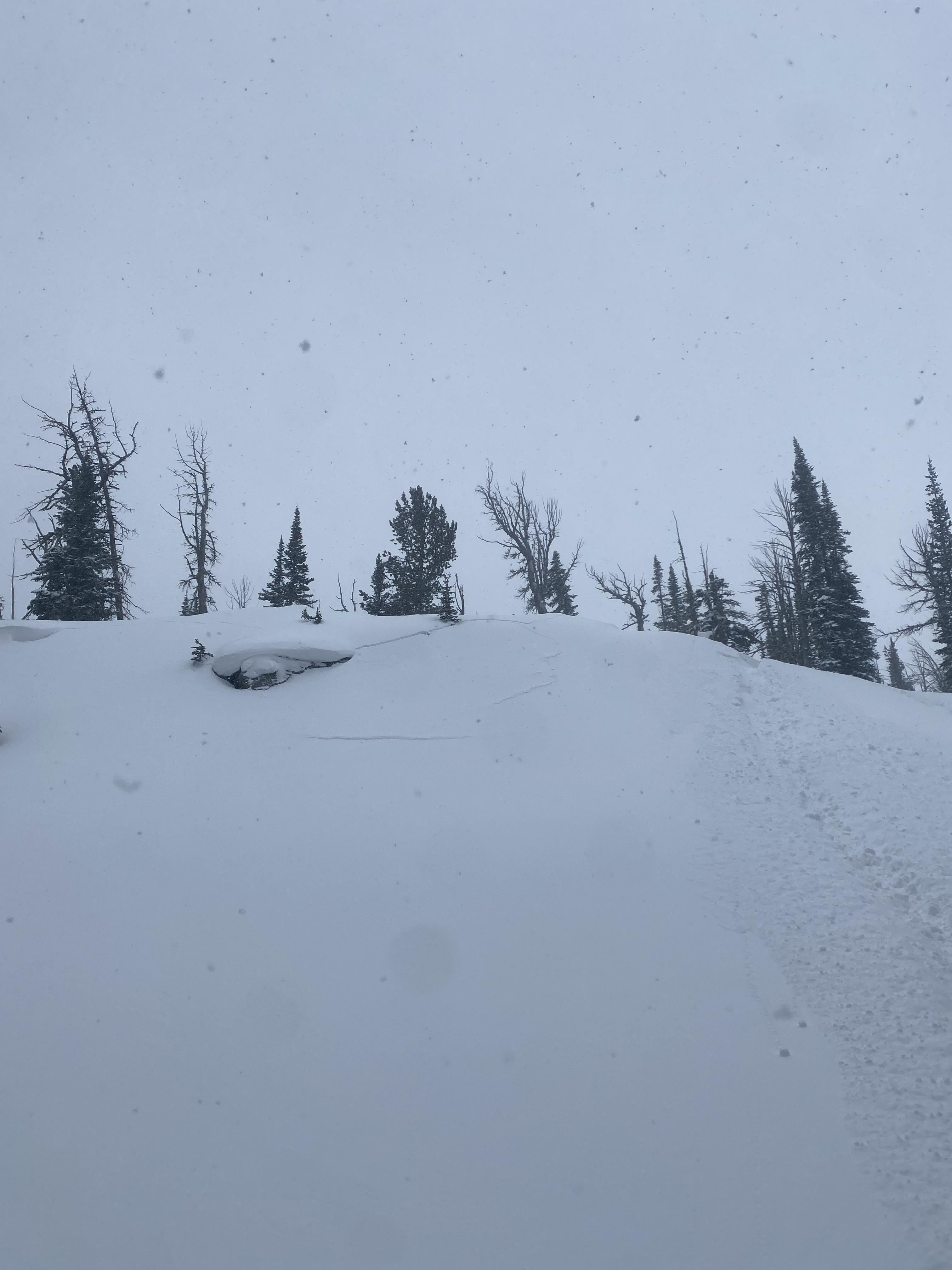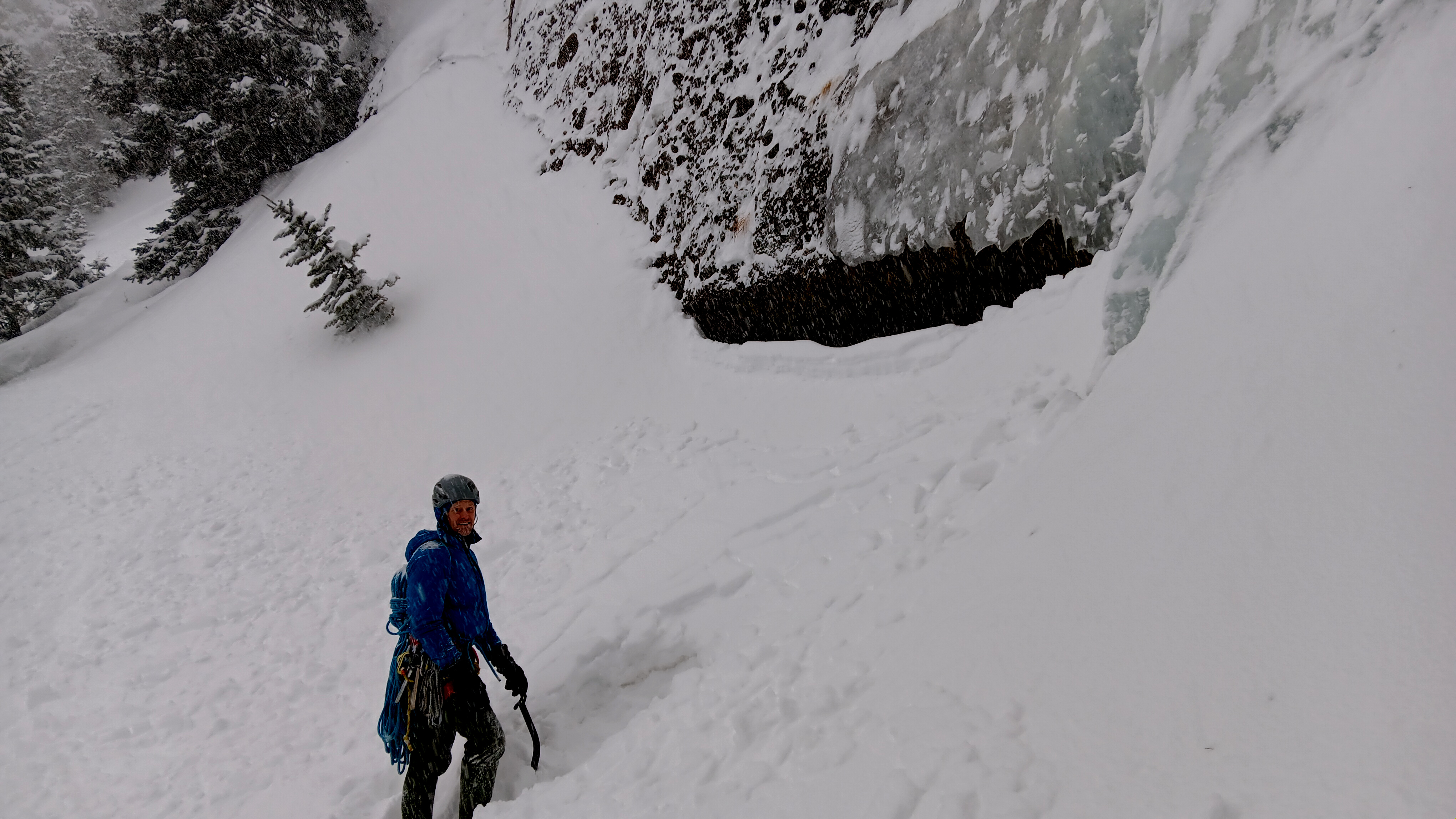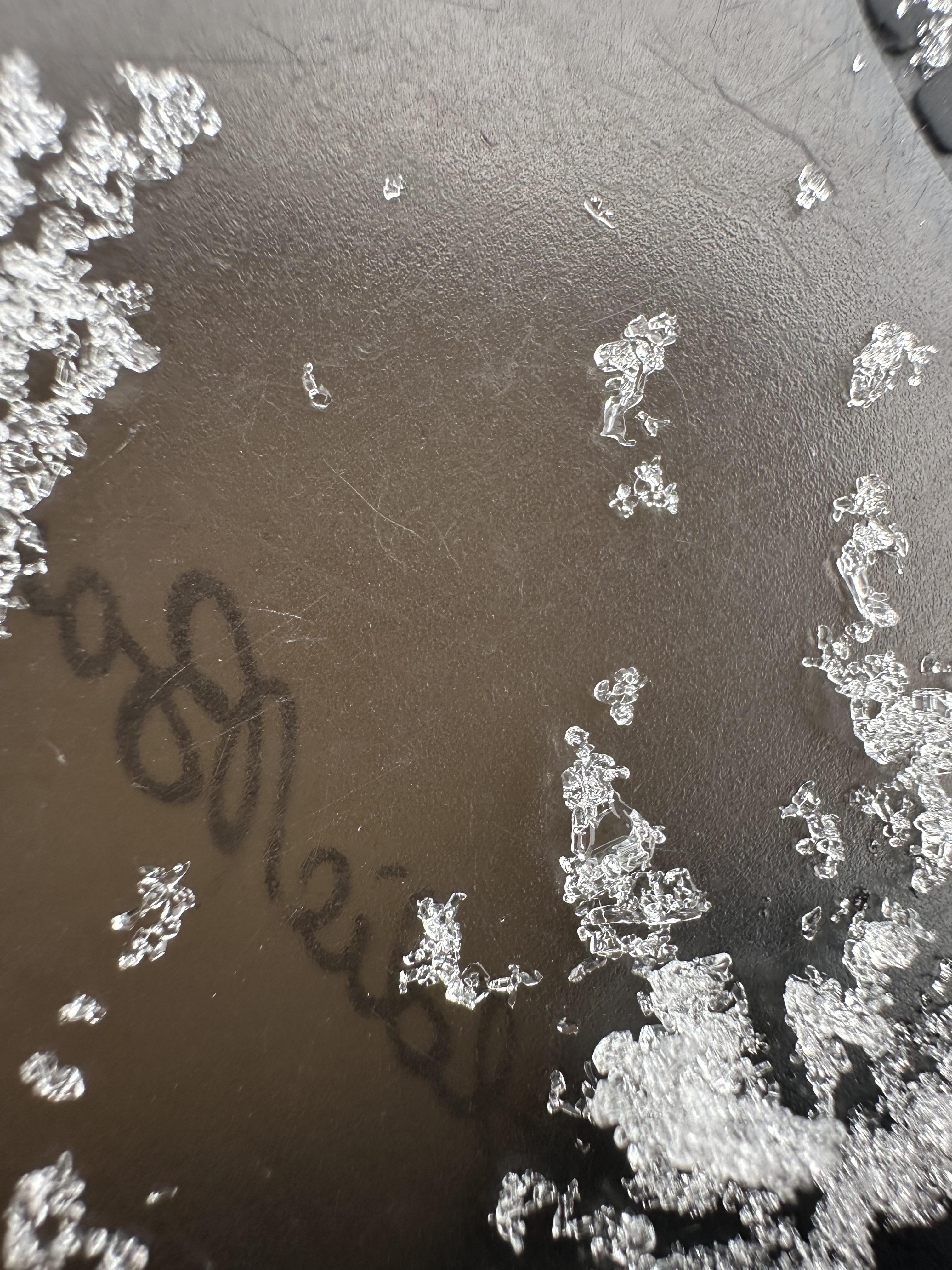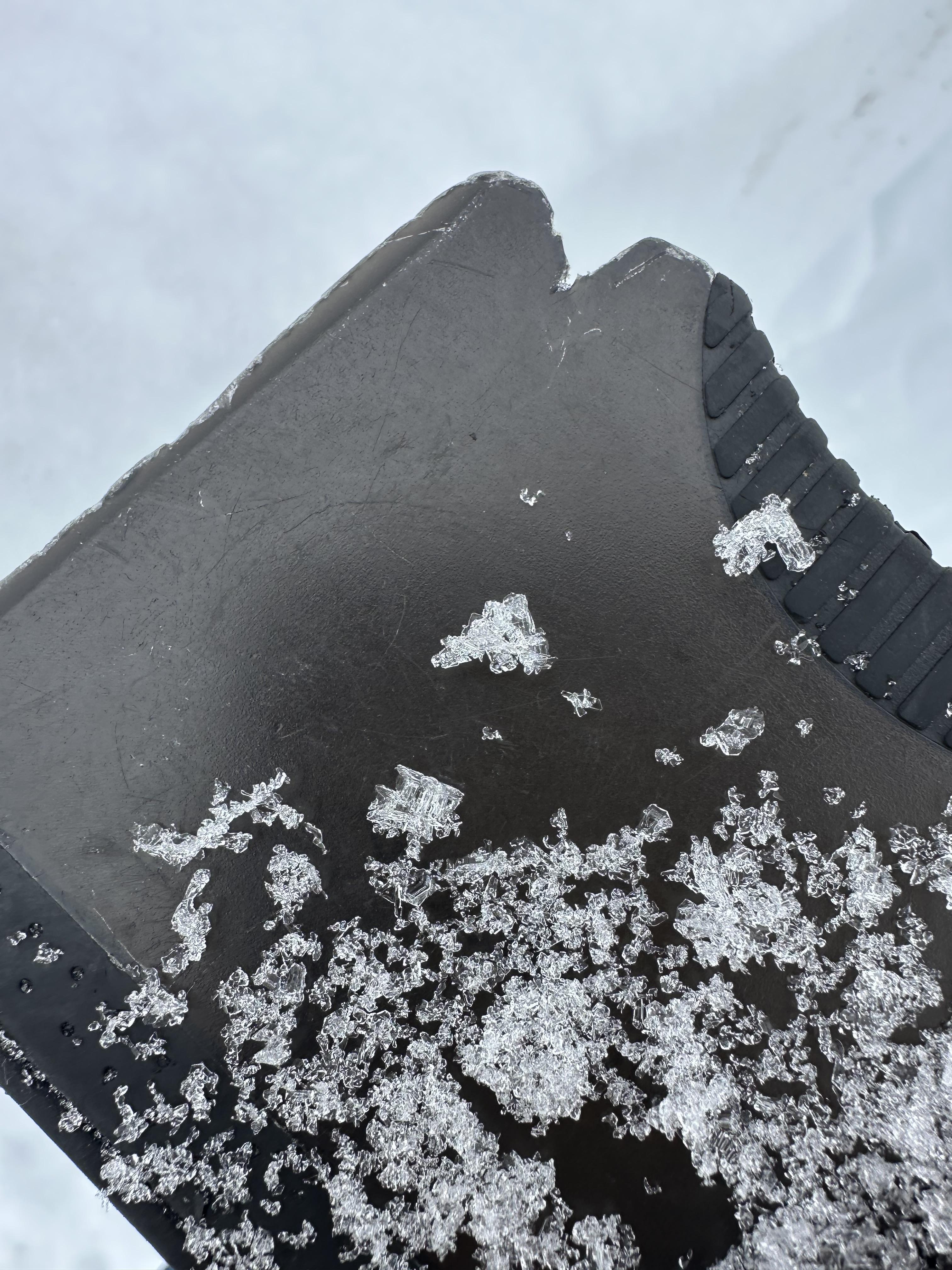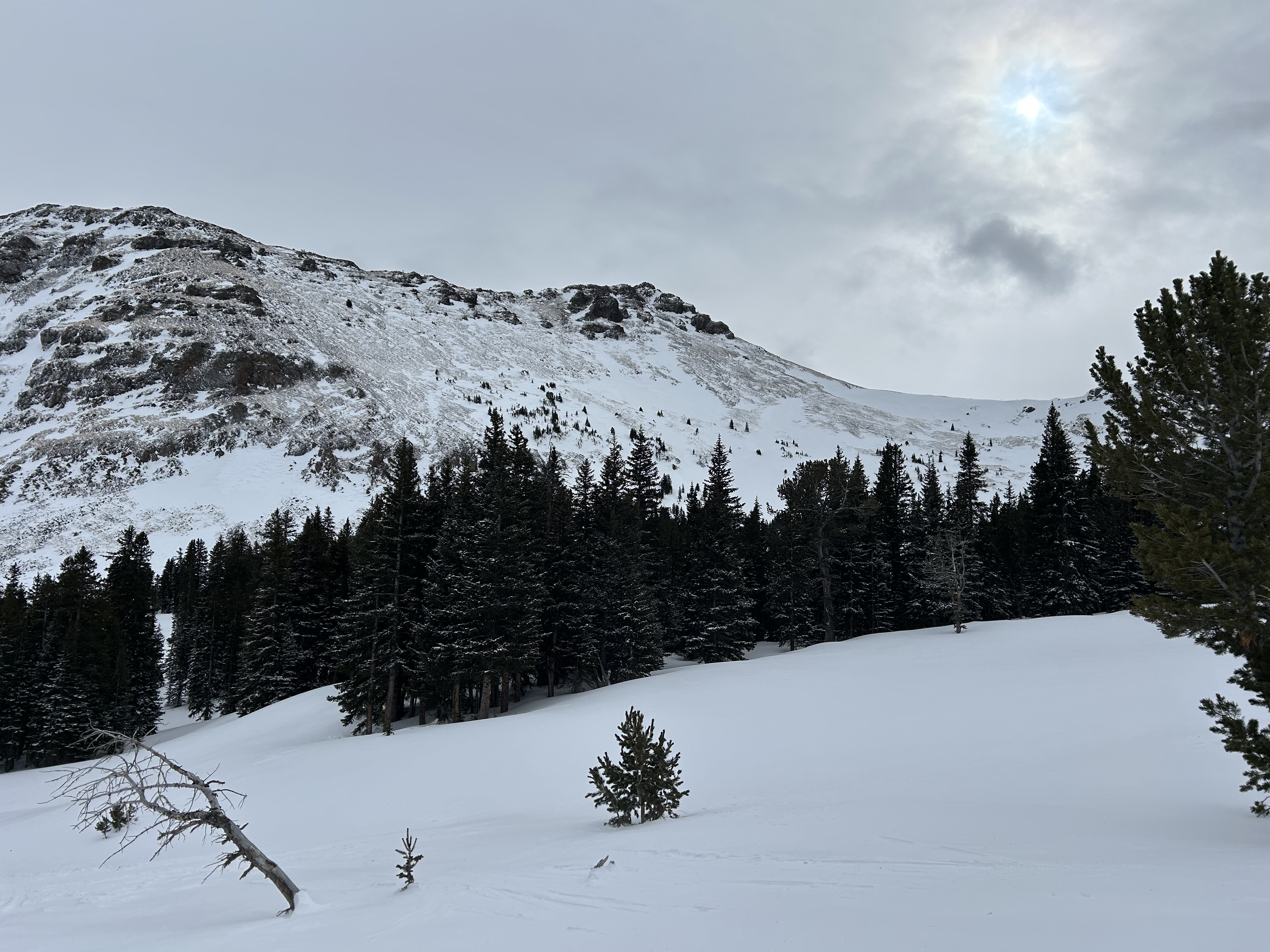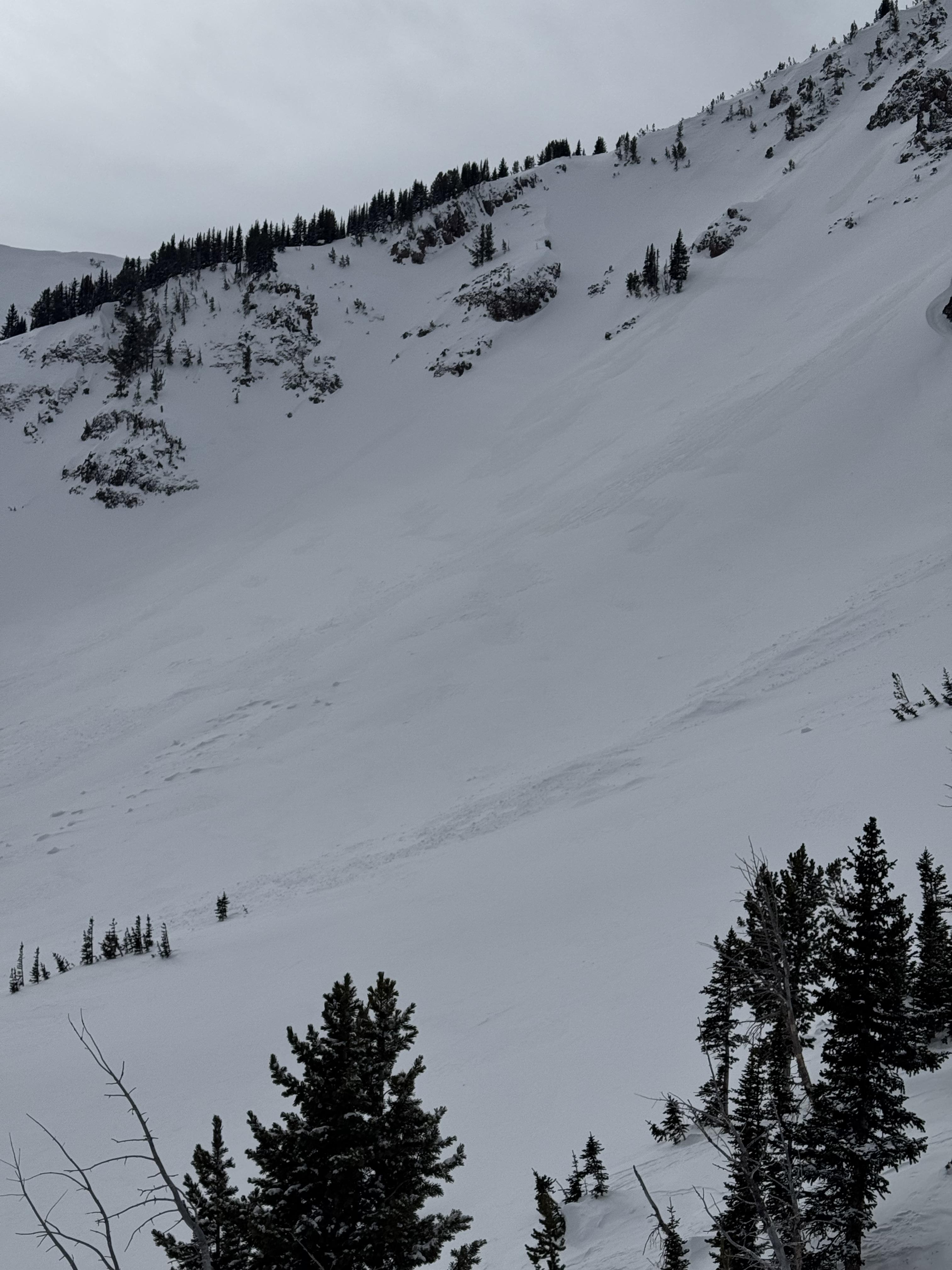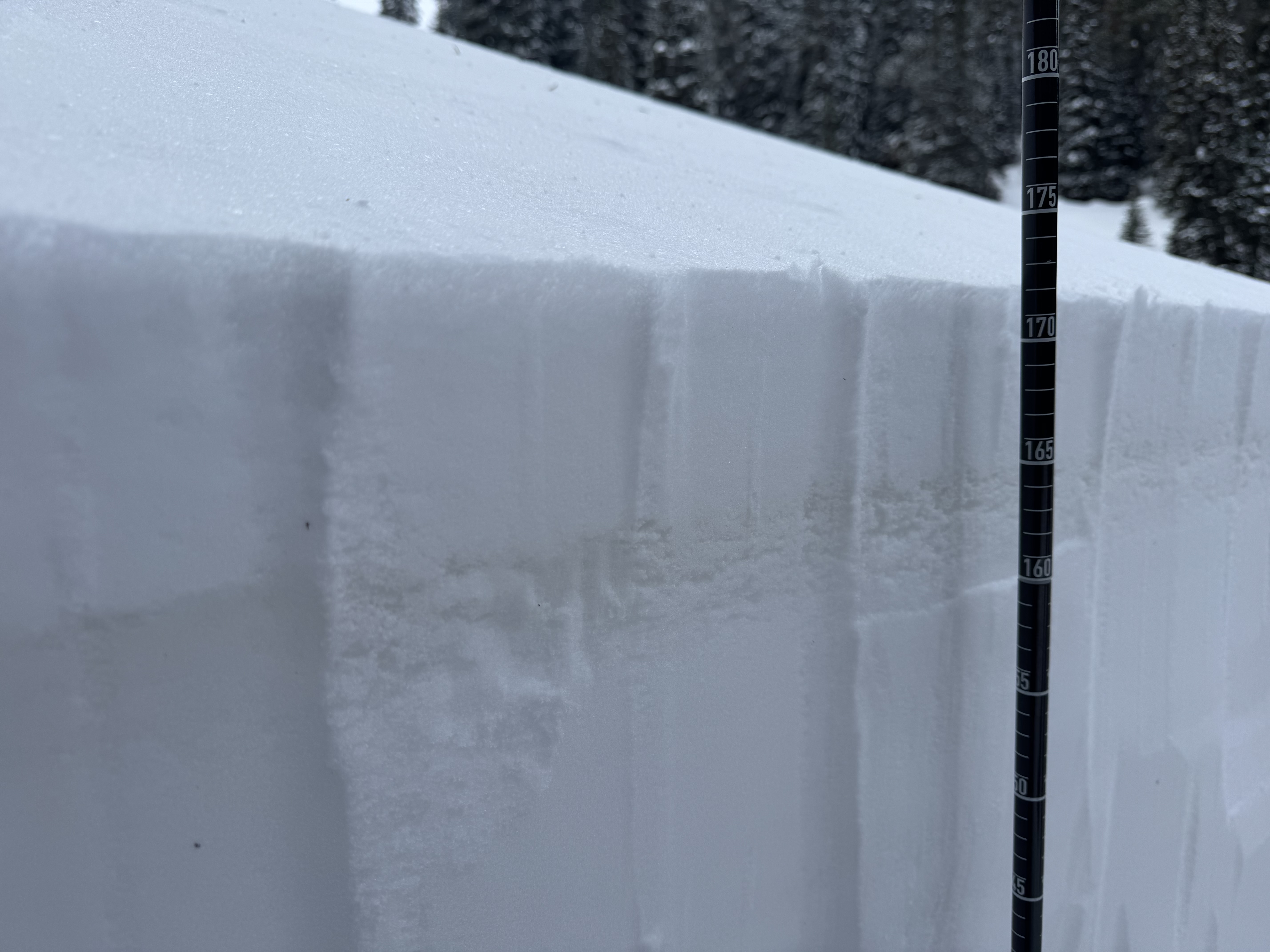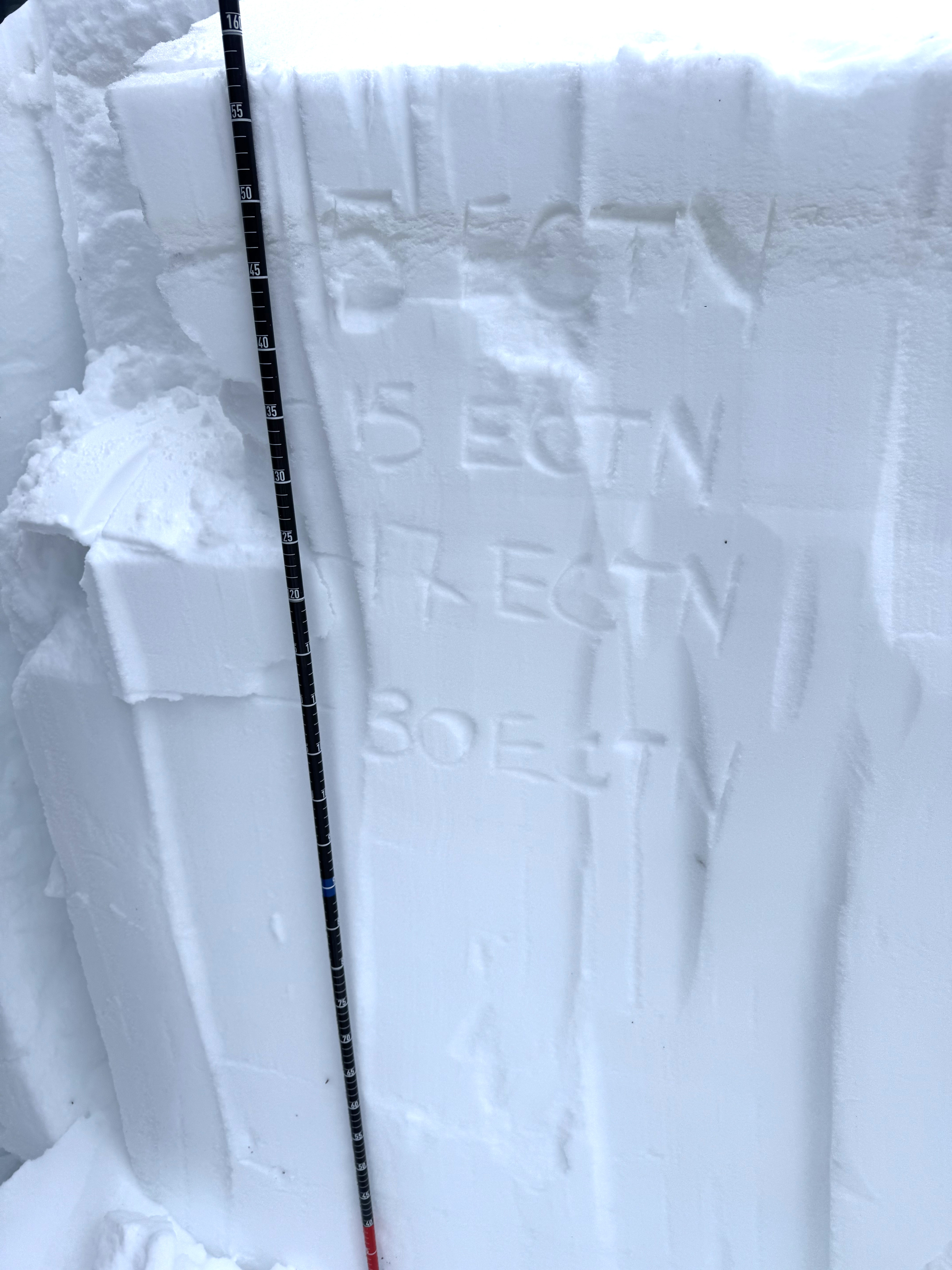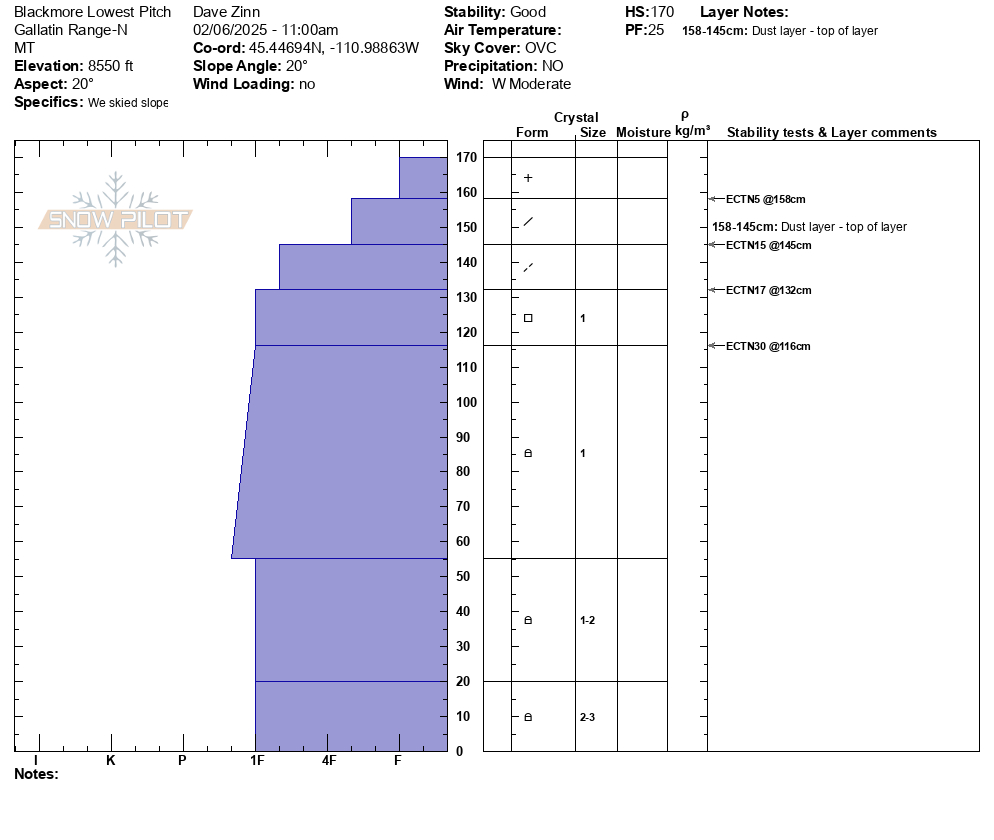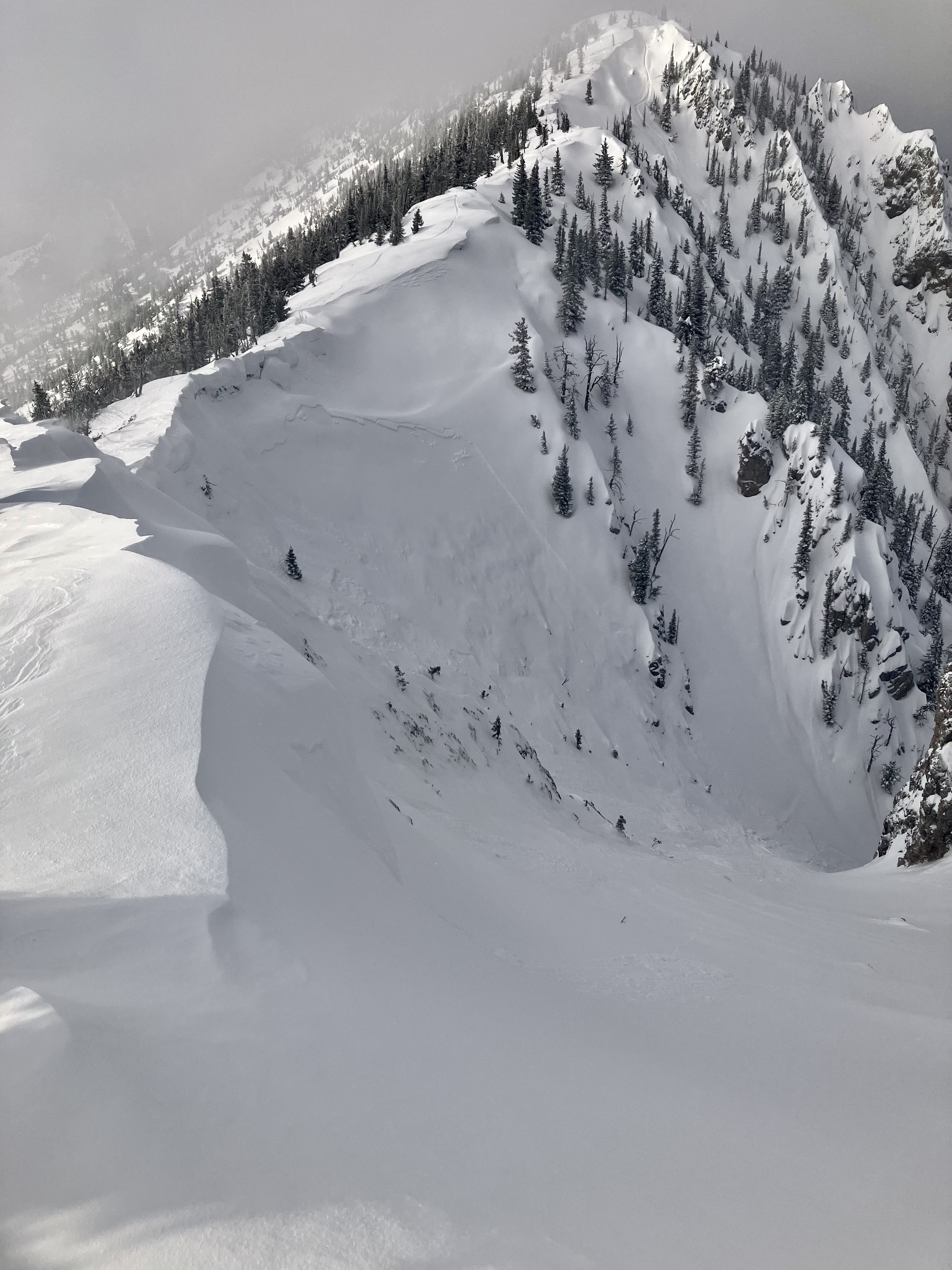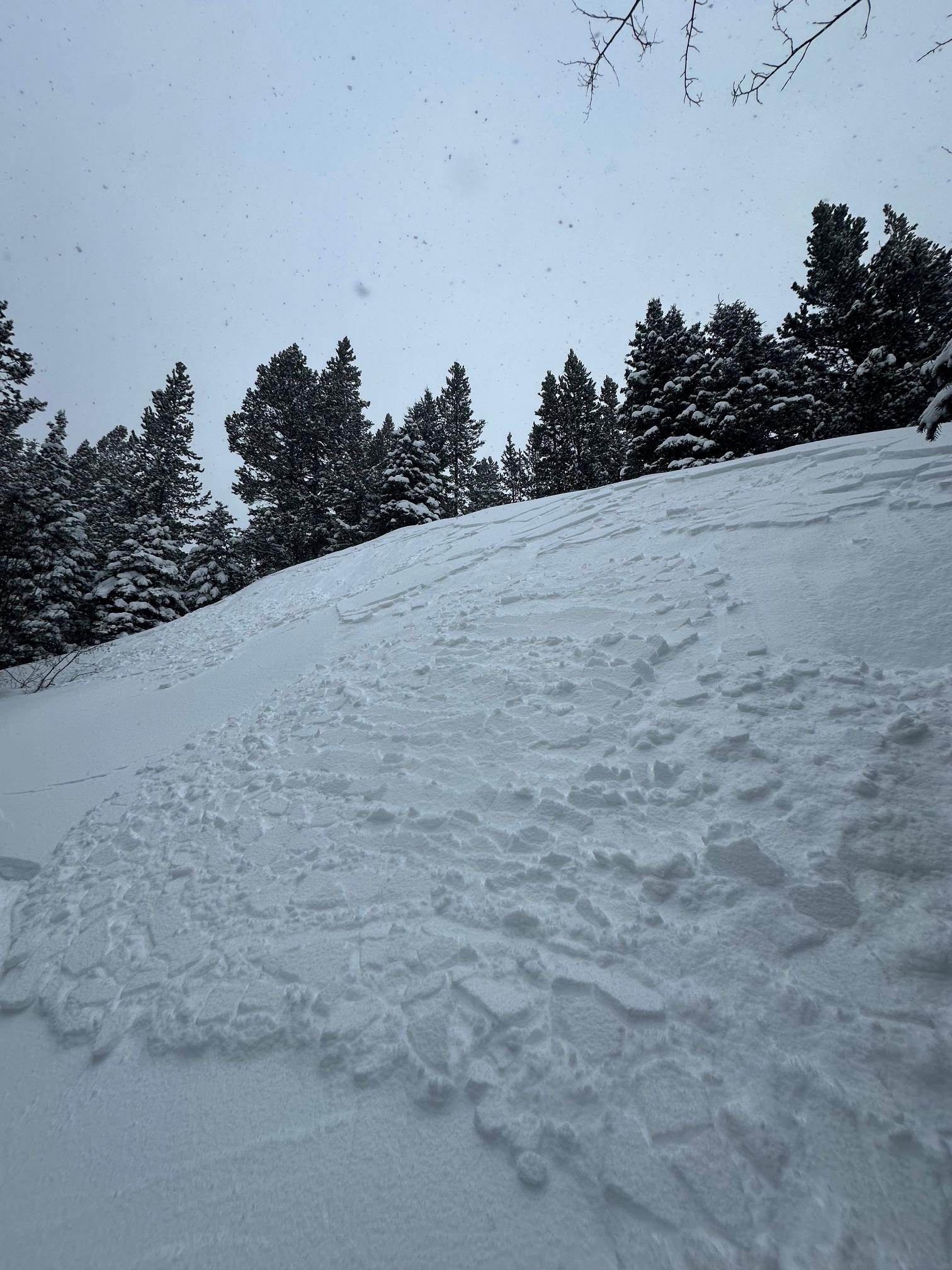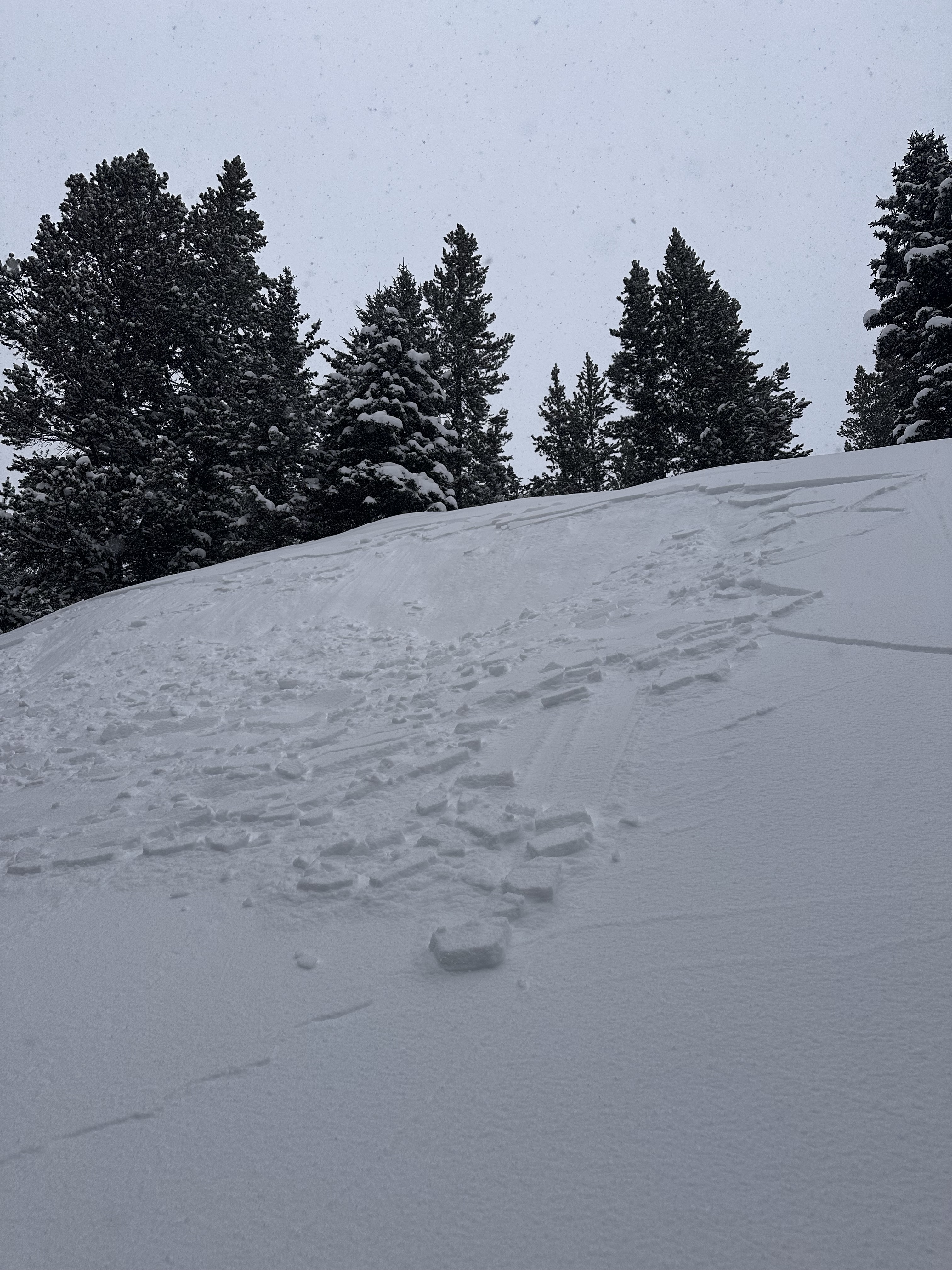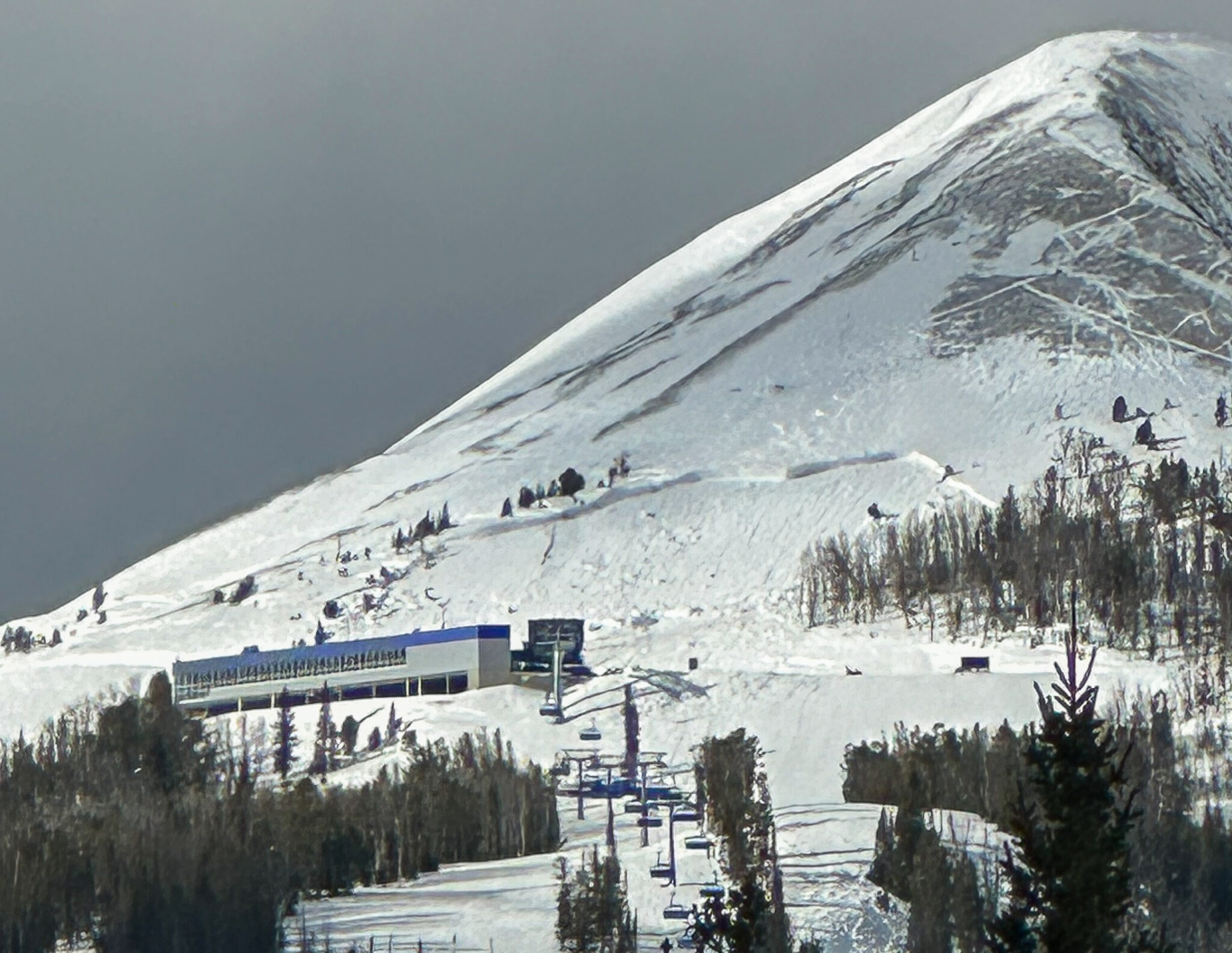Snow Observations List
We did not find any signs of weak layers from the recent high pressure while touring throughout Bradley Meadows area.
HS of 125-155cm in Bradley Forest North, 130-200cm in Wolverine woods. CT4-12Q2 down 25 (new/old interface), ECTN x 3 in Bradley Forest North.
Moderate/high winds, Few clouds, no precip, air temp 5F deg around 2pm.
Full Snow Observation Report
This afternoon we rode up to Henderson Bench, then up Lulu road to the Cabins below Scotch Bonnet. It was snowing lightly most of the day with light to moderate wind. Wind was steady moderate near Lulu Pass. Visibility was limited, but we got a brief look at some of Henderson Bench and Scotch Bonnet.
We saw 3 avalanche that broke 6-10" deep within the recent snow, R1-D1s, 20-40' wide.
For the next 1-2 days I expect any fresh drifts will be easy to trigger. There are some density changes within the recent snow that could cause storm slab avalanches to break easier on non-wind loaded slopes.
We dug on a northeast facing slope at 9,360' elevation. Below the dust layer that was deposited at the end of last week's storm there is a lower density layer of precipitation particles that was preserved. This produced an ECTN in our test, but seems like it could contribute to avalanches for the next few days at least. (profile attached).
Snow that fell since last weekend was settled to about 2.5-3 feet. We did find some small facets buried below the last week's snow, but they were not showing obvious signs of being a widespread problem. I am still cautious that larger, wider avalanches could break on this facet layer until the snowpack has 1-3 more days to adjust to the weight of recent snow, especially on wind-loaded slopes.
Practice cautious route finding and careful snowpack assessment as avalanches are likely within the recent snow, and possibly could break 2-4 feet deep below all the snow that fell over the last week.
Full Snow Observation ReportOverall, the snowpack seems to lack widespead pwl problem (below the recent snow), but visibility and digging was limited today. I remain hesitant until we can gather more evidence and give the snowpack more time. Potential for wind slab and storm slabs seems enough to warrant CONSIDERABLE danger. Danger could come down quickly as loading tapers off, but this could change if we see something different tomorrow like concerning pit results or larger avalanches.
Toured into the north Gallatin today and skied on north facing terrain. Saw obvious loading in the new snow up high on the ridge lines, but no recent natural avalanches. We encountered several debris piles that were covered by new snow, probably from a few days ago and likely wind slabs based on the terrain. Skiing, we triggered 3 wind slabs (ss-d1-r1) on a north west facing slope at around 7800’, each ran the entirety of the face. Notably, one of the slabs propagated above the skier and about 20-25 ft to the right. Skiing a north east slope (slightly more sheltered), no signs of instability were observed. We didn’t observe a weak layer underneath the most recent new snow, but we did see a layer of dust and crust deeper in the pack.
Full Snow Observation ReportSaw this small soft slab above Round Lake today. SE facing, 9500 ft. Likely skier triggered, there were lots of ski tracks on that hill.
Poor visibility today but no other avalanches observed.
Full Snow Observation ReportI went skate skiing up Sourdough Canyon today. The trail intersects a significant amount of south and southwest-facing avalanche terrain that generally does not have much snow coverage due to exposure to the sun.
However, the snowpack is much deeper than normal in the Gallatin Valley and in the low-elevation mountains around the Valley, and these slopes make me nervous, especially because they would impact a trail that sees heavy use by people who do not intend to expose themselves to avalanches and who are not prepared for avalanche rescue.
Currently, 2.5 to 4 feet of snow is in the terrain near the trail.
These slopes WILL probably avalanche when:
- We get the first sunny, warm day.
They MIGHT avalanche when:
- We get another big storm.
- People or animals traverse or choose to ski above the trail and inadvertently trigger a slide.
What you should do:
- Recognize that ALL steep, snow-covered terrain (30 degrees plus) has avalanche potential.
- If you choose to recreate in abnormal locations, there may be abnormal considerations and consequences--there are families, kids, and dogs below you.
- SO, Be cautious and respectful of other users. One good way to do this is to AVOID traveling in avalanche terrain above unsuspecting travelers.
Full Snow Observation Report
We rode below the Throne and towards Fairy Lake, mostly at elevations 6,800-7,500'. It snowed steady S1-2 most of the day and tapered off in the afternoon. Wind was a stout moderate out of the east and south in the parking lot. Wind was light to moderate out of the south up higher/"mid-mountain". There was a brief clearing mid-day and we could see the bowl and ridge south of Naya Nuki.
We saw a couple storm slabs that broke in today's snow 4-6" deep, 10-30' wide, and we triggered one 3-4" deep wind slab, "remotely", from a few feet back on a small ridgeline. R2-D1. These slabs were very soft, F- to F hard.
The interface below this week's storm was generally well bonded to the surface below and lacked a weak layer from the recent high pressure. I would not totally rule out the potential of something breaking wider on a weak layer because we did not get a good look at higher elevations, but so far it seems less likely to have a persistent slab problem involving a layer below this week's snow in the Bridgers as compared to other parts of our forecast area.
Full Snow Observation ReportAt the base of G2 I triggered a 3 inch x 100 foot soft slab. I was surprised how far it propagated. It looked like it failed on a density change under the morning's new snow. 40 feet up on the first large bench we triggered another slide, 6 inches deep, the entire width of the bench. It could have pushed a climber off if they were in the middle of it. It was snowing steady (1"/hr) and wind was minimal, but a few hours later we could see plumes higher up in the gullies.
It had such zip to the propagation that I'm thinking it might take a day for it to not be reactive. There was no way we wanted to get on anything open and steep.
Full Snow Observation ReportDug on a NE aspect at about 7800’ on Mt. Ellis. Noticed pretty significant wind loading/cornice development from yesterday and was easily able to get small cornices to break off. Most notable test result was ECTP16 down 35 cm on a layer of surface hoar. Besides the concerning surface hoar layer the snowpack was generally right side up and seemed pretty solid. Photo of pit profile attached.
Full Snow Observation ReportWe toured up the standard ascent route on Mount Blackmore to the shoulder. Three to four inches of new snow from yesterday sat on top of the dust layer that got deposited across most of the forecast area on Monday and Tuesday.
We stopped and dug a full pit on the lowest pitch of skiing and found good stability in this wind-sheltered terrain. Incidentally, this lowest pitch was also the best skiing by a large margin. All the terrain above this was very wind-affected. We were looking for near-surface facets and surface hoar that formed last week and got buried by recent snow in some areas. We didn't find it. This bodes well for long-term stability, but we'll keep looking. Test scores were unremarkable, ECTN5 below yesterday's snow, ECTN15, 17, and 30 at various levels within last weekend's storm snow. No other failures, no propagation.
The wind had hammered snow surfaces at all elevations above this. Surfaces stiffened. There was a tree that blew over recently. Elephant Mountain and the summer trail area were scoured down to the tundra. There was evidence of several R1-2/ D1-2 wind slab avalanches that likely ran this weekend on the east face of Blackmore.
We dug again on the shoulder with unremarkable results and no evidence of new weak layers that will be players.
Bottom Line:
- Wind effect is widespread.
- It is difficult to tell precisely where loading occurred with the fresh snow covering drifts. You won't know until you move into the terrain and feel the underlying snow stiffen under your skis, board, or sled (I don't like not knowing).
- We didn't find any evidence of new weak layers of concern.
Manage it by:
- Maintaining a conservative mindset in all upper-elevation terrain that isn't obviously scoured.
- If you want to ski and ride in steeper terrain (slopes above 30 degrees), do so at lower elevations on slopes sheltered from the wind. We didn't find new weak layers below this weekend's snow, but I would still dig 2-3 feet down to look for them before committing to avalanche terrain.
Skied south of Cooke today. Winds were strong with frequent gusts to extreme out of the S. 3cm of new between 1530 and 1700. No cr, co and the wind slab produced moderate, non-planar results in hand pits. Limited vis and no avalanches observed.
Full Snow Observation ReportToured up the ramp and north towards hourglass couloir right after heavy snowfall at Bridger. Observed presumably natural wind slab avalanche crown at top of Hourglass (picture). Broke roughly 200ft wide and rather shallow, did not manage to run fully into the apron. Also noted many other small natural avalanches almost all breaking right at the top of the ridge. Strong winds from west loading slopes. Followed some solo tracks down just skiers left of hourglass, noted some instability but no major propagation or slides while skiing. Storm slab not quite cohesive this evening, but could definitely see it getting pretty spooky tomorrow.
Full Snow Observation ReportHad several large whumphs in windslabs at the top of bacon rind today. Interestingly they only started once a few inches of new snow had accumulated from the cold front. At the end of the day the windslabs are out there with enough load to make them pretty touchy.
No obvious signs of instability where there was no wind loading.
Full Snow Observation ReportFigured I would send in some observations as we were out yesterday in Whits Lake back in Dutchman's Basin and with extreme wind the snow was getting moved around and the wind was putting snow in unusual locations. This was a wind loaded hill but a very shallow angle hill maybe 20-25 degrees. Snow broke on an old layer before this past weekend's storm, that slab was probably 14-24" think in spots. Snow was generally stable other than wind blown spots.
Full Snow Observation ReportAfter skiing Bradley's Meadow, we skied north into Wolverine Bowl aiming to go up the backside of Texas Meadows. When we were in the large flat meadow to the north of Hourglass Chute we heard two avalanches come down from the ridge a few hundred yards north of Hourglass. Too low of vis to estimate size or see anything but the powder clouds come over the bottom cliffs.
Full Snow Observation ReportNew storm snow accumulating over the course of the morning became quite reactive once we descended out of the inversion. Significant change starting around 7,200', where the surface had remained cold. We didn't observe any signs of instability while skiing between ~8,200' and ~7,200'.
Photo is a of remote trigger, SE facing slope, ~100' crown, ~3" depth. Lots of shooting cracks and smaller remote triggers while touring out the FS roads.
Full Snow Observation ReportSkied big Ellis this morning. The temperature inversion was still active but not as dramatic as yesterday. The snow in the warm zone, near the top, of the inversion was well bonded and clearly affected by warmer temps. It was snowing hard up there but coming down as graupel. In the cold zone of the inversion the new snow was extremely active. We were remote triggering every small slope we passed on the gully exit. We saw many naturals breaking on any large open slope in the gully. The snow on the cold side of the inversion was blower but not bonding well at all. Could be a very sketchy setup if you find your self skiing in avy terrain that stayed cold over the last few days.
Full Snow Observation ReportSkied the East Meadows of Ross Peak, had about 4 inches of fresh snow come down in 2 hours. Lots of cracking and small storm slabs remote triggering on small rollovers on the way out. This was a small remote trigger next to the skin track, about 20 feet wide by 10 feet long. New wet snow seemed especially poorly bonded with the old snow below 7000 feet where the snow fell on very cold snow from affected by the inversion.
Full Snow Observation ReportStarted touring from the road around 8:30, with temps just above 0F. Half an hour later and 200 feet higher (~6150 feet) we were down to base layers and temps were above freezing. The top 5cm of surface snow was moist for most of our tour, with about 15-20 cm of dry snow below, overlying a buried crust in most areas.
As we got higher (~7000 ft) we noticed roller balls from the previous day, as well as dust on the snow surface.
Above 8000 feet surface snow became mostly dry on northerly aspects but a surface MFcr or a thin layer of moist surface snow still existed on southerly aspects. We skied a northly aspect first and it wasn't too bad.
Around noon graupel showers turned into S2 snowfall with sustained strong winds at ridgetop. A very abrupt change in weather and snow conditions. As we descended and drove back to Bozeman the temperature inversion was still going strong.
Our main thoughts are that this bodes for weird things to come. The snow yesterday was falling on a crust at higher elevations, but burying cold (potentially faceted?) snow at lower elevations. There were signs of developing wet snow problems at higher elevations but mid-winter conditions at lower elevations. It seems like our standard way of thinking about avalanche problems/hazard distribution may have to become inverted along with the temperatures.
Full Snow Observation Report
Swift Current lift shut down all day Wednesday 2/5/25 by ski patrol
Full Snow Observation Report
